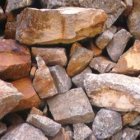 | |||||
| About Us | Contact Us | Services | Copyright | |||||
|
|||||
|
What are Rocks and Minerals? By Marilyn Fraser
MineralsWhat is the difference between a mineral and a rock? Minerals are the "building blocks" from which rocks are made. Some minerals, such as gold, sulphur and copper, consist entirely of one chemical element. These minerals are called Native Elements.Other minerals are more complicated mixtures of elements. But the composition of each mineral is always the same. For example, Quartz is always one third silicon and two thirds oxygen. Halite (the "official" name for salt) is always one atom of sodium to each one of chlorine. RocksRocks are nearly always mixtures of minerals, and because they are formed in different ways (or even changed after they are formed) they can vary quite a lot. For example, granite is usually about 20% quartz, 75% feldspar and 5% mica, but these proportions vary and the rock often contains small amounts of other minerals as well.What are Rocks and Minerals
Man has been using minerals in his everyday life ever since he discovered a sharp-edged piece of flint made an excellent tool or weapon.
|
||||

Copyright © 2000 Canadian Rockhound
Magazine Issues |
News & Events |
Junior Rockhound |
Resources
|
||||


